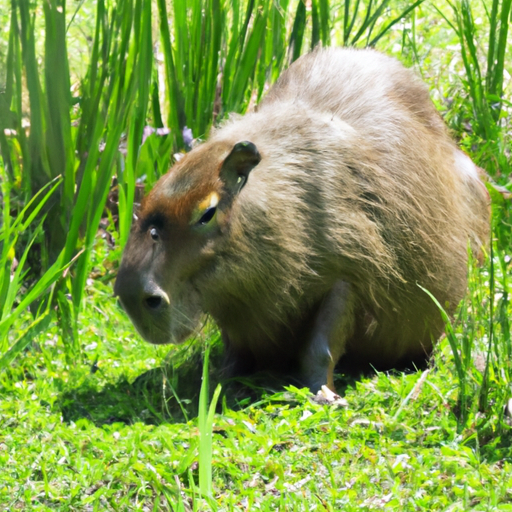Have you ever wondered what type of food capybaras, those adorable and social creatures, munch on? As the largest rodents in the world, their diet is quite unique. Capybaras are herbivorous, which means they primarily feed on plant material. Their diet consists of grasses, aquatic plants, fruits, and even bark and leaves from certain trees. In this article, we will explore the fascinating dietary preferences of capybaras and delve into the reasons behind their varied food choices. Get ready to discover the intriguing world of capybara cuisine!
Capybaras: An Overview
Capybaras are fascinating creatures that are often referred to as the giants of the rodent family. They are the largest rodents in the world, resembling oversized guinea pigs. Native to South America, particularly in the wetlands of the Amazon Basin, they have also been introduced to other regions of the world due to their popularity as exotic pets. Capybaras are semi-aquatic animals, known for their friendly and sociable nature. They are highly adaptable creatures and have successfully thrived in diverse habitats.
What are Capybaras?
Capybaras (Hydrochoerus hydrochaeris) are herbivorous mammals and belong to the family Caviidae. They have a sturdy body structure with barrel-shaped torsos, short limbs, and webbed feet, making them excellent swimmers. Typical adult capybaras can reach a length of about four feet (120 cm) and weigh between 75 to 150 pounds (34 to 68 kilograms). These social animals are often seen in groups known as “capybara herds,” which can consist of up to 30 individuals.
Physical Characteristics of Capybaras
Capybaras have a unique appearance that distinguishes them from other animals. Their short, blunt heads feature rounded ears and small, dark eyes. The most striking physical characteristic of capybaras is their large teeth, which constantly grow throughout their lives. These ever-growing incisors are adapted for grazing on a variety of vegetation. Capybaras also possess partially webbed feet, an adaptation that enables them to efficiently move through water and muddy terrains.
Distribution and Habitat
Capybaras primarily inhabit the vast wetlands, marshes, and swamps of South America. They are native to countries such as Brazil, Venezuela, Colombia, and Argentina. However, due to their adaptability, capybaras have been introduced to regions outside of South America, including parts of North America, Europe, and Asia. They are well-suited to a variety of habitats, including grasslands, forests, and even human-inhabited areas near water bodies.
Capybara Diet in the Wild
Herbivorous Nature of Capybaras
Capybaras have a strictly herbivorous diet, meaning they only consume plant-based materials. They are well-adapted to consuming a wide range of vegetation, which plays a vital role in meeting their nutritional needs.
Primary Food Sources
Grasses, leafy vegetation, aquatic plants, barks, stems, fruits, and berries are the primary food sources for capybaras. They have evolved to digest these plant materials effectively.
Variety of Vegetation Consumed
Capybaras have a diverse palate and consume various types of vegetation to fulfill their dietary requirements. They are known to feed on grasses, leaves, aquatic plants, barks, stems, and even occasional fruits and berries. This broad range of plant food allows them to adapt to different environments and maintain a balanced diet.
Foraging Behavior
Capybaras are selective foragers and display specific foraging behavior depending on the type of vegetation. Their grazing behavior is most commonly observed when feeding on grasses, while they exhibit browsing behavior when consuming leaves or branches. These specialized foraging techniques allow capybaras to obtain optimum nutrition from their plant-based diet.
The Role of Water in Capybara Diet
Importance of Water for Capybaras
Water plays a vital role in the life of capybaras, not only for their survival but also for their dietary needs. Capybaras are semi-aquatic animals, spending a significant amount of time in or near water bodies. They depend on water for various activities, including drinking, regulating body temperature, and accessing their preferred food sources.
Preference for Aquatic Plants
Capybaras have a particular fondness for aquatic plants, which serve as an essential component of their diet. They are well-adapted to feed on floating plants, submerged vegetation, and even water lilies. Aquatic plants provide capybaras with essential nutrients and hydration, making them a preferred food source.
Drinking Habits
In addition to consuming water through their diets, capybaras also engage in regular drinking habits. They often submerge themselves in shallow water bodies to quench their thirst and cool down their bodies. This behavior is not only necessary for hydration but also aids in the digestion of their fibrous plant-based diet.
Grasses: A Staple Food for Capybaras
Prevalence of Grasses in Their Diet
Grasses are a staple food source for capybaras and play a significant role in their daily dietary intake. They are readily available in various habitats, making them an easily accessible and abundant food source for capybaras.
Types of Grasses Consumed
Capybaras graze on a wide variety of grass species, such as Bermuda grass, paspalum grass, and reeds. They have evolved to efficiently extract nutrients from grass blades, making grasses a crucial part of their diet.
Foraging Behavior around Grasses
Capybaras display grazing behavior when feeding on grasses. They often move in herds across grasslands, leisurely grazing on the vegetation around them. Their teeth are well-suited for gnawing and grinding tough grass fibers, allowing them to extract the maximum nutrition from this essential food source.
Leafy Vegetation: Nourishment for Capybaras
Leafy Plants in the Diet
Leafy vegetation forms an integral part of the capybara diet, offering them a rich source of essential nutrients. Capybaras actively seek out and consume a variety of leaves to meet their dietary requirements.
Preferred Types of Leaves
Capybaras favor the tender leaves of various plants, including the leaves of water hyacinth, clover, lettuce, and alfalfa. These leafy greens provide capybaras with a diverse range of vitamins and minerals necessary for their overall health and well-being.
Foraging Habits
When foraging for leaves, capybaras employ browsing behavior. They selectively nibble on leaves, avoiding older or tougher foliage. Their mobile lips and incisors help them carefully pluck the desired leaves while minimizing the ingestion of unwanted plant parts.
Aquatic Plants: A Munch for Capybaras
Role of Aquatic Plants in Their Diet
Aquatic plants hold great significance in the capybara diet, as they provide essential nutrients and hydration. Capybaras have evolved to take advantage of the abundant vegetation found in and around water bodies.
Commonly Consumed Aquatic Plants
Capybaras consume a wide range of aquatic plants, including water hyacinth, water lettuce, and duckweed. These plants grow abundantly in marshes, swamps, and shallow ponds, allowing capybaras to effortlessly feed on them.
Foraging Behavior near Water Bodies
Capybaras often spend significant amounts of time near water bodies, making it easier for them to access their preferred aquatic plants. They can be observed wading through shallow waters and using their dexterous lips to grab floating or protruding vegetation. This behavior demonstrates their adaptation to an aquatic environment and the vital role of aquatic plants in their diet.
Barks and Stems: Secondary Plant Food
Inclusion of Barks and Stems in the Diet
Although less prominent in their diet, capybaras also consume barks and stems as a supplementary food source. These plant parts provide additional nutrients and contribute to their overall diet.
Types of Barks and Stems Consumed
Capybaras chew on the barks and stems of various trees and shrubs like willows, bamboo, and cattails. While not a primary food source, these plant parts offer capybaras additional dietary variety and help fulfill their chewing and gnawing instincts.
Reasons for Consuming Barks and Stems
Consuming barks and stems aids capybaras in wearing down their continuously growing incisors. By chewing on tough plant materials, they prevent dental problems and maintain proper dental health.
Fruits and Berries: A Treat for Capybaras
Occasional Consumption of Fruits and Berries
Although primarily herbivorous, capybaras occasionally enjoy indulging in fruits and berries when they come across them. While not a significant part of their diet, these sweet treats provide capybaras with a pleasant change in taste and texture.
Preferred Types of Fruits
Capybaras may consume fruits such as melons, citrus fruits, and even bananas if available. These fruits provide a burst of natural sugars and can act as a source of hydration and a temporary source of energy for capybaras.
Foraging Behavior for Fruits
When capybaras stumble upon fruits or berries, they will use their dexterous lips to pluck them from branches or the ground. However, their consumption of fruits is relatively rare compared to their consumption of other plant-based materials.
Nutritional Requirements of Capybaras
Essential Nutrients for Capybaras
Capybaras require a balanced intake of essential nutrients to maintain their overall health and well-being. These nutrients include carbohydrates, proteins, fats, vitamins, and minerals, which they derive from their herbivorous diet.
Role of Dietary Fiber
Dietary fiber is a crucial component of the capybara diet. It aids their digestive process, promotes healthy gut bacteria, and ensures efficient absorption of nutrients from plant materials. Capybaras gain an adequate amount of dietary fiber through their consumption of grasses, leaves, and other plant sources.
Importance of Vitamin C
Capybaras, like humans, are unable to produce their own vitamin C. Therefore, they must obtain this essential nutrient from their diet. Fortunately, their herbivorous diet, rich in various plant-based materials, provides them with sufficient vitamin C.
Human Interaction and Diet
Capybaras and Agricultural Crops
As human settlements expand and encroach upon natural habitats, capybaras often adopt agricultural areas as part of their habitat. This proximity to crops introduces new food sources to their diet, including agricultural produce such as grains and vegetables.
Impact of Human Interference
While capybaras may opportunistically consume human-grown crops, it is important to manage their interaction with agricultural areas to prevent agricultural losses. Encouraging a symbiotic relationship and implementing strategies to prevent excessive damage to crops is crucial for coexistence.
Ensuring a Balanced Diet
While capybaras have adapted to diverse diets, it’s important to ensure they maintain a balanced, species-appropriate diet even in human-altered environments. Conservation efforts should focus on preserving their natural habitats and promoting healthy coexistence practices to protect their long-term well-being.
In conclusion, capybaras are delightful creatures with unique dietary habits. Their herbivorous nature and diverse food preferences allow them to thrive in a variety of habitats. From grazing on grasses to indulging in occasional fruits, capybaras have adapted to extract maximum nutrition from their plant-based diet. Understanding their dietary needs and ensuring a healthy balance between natural habitats and human-altered environments is essential in promoting the well-being of these fascinating animals.






